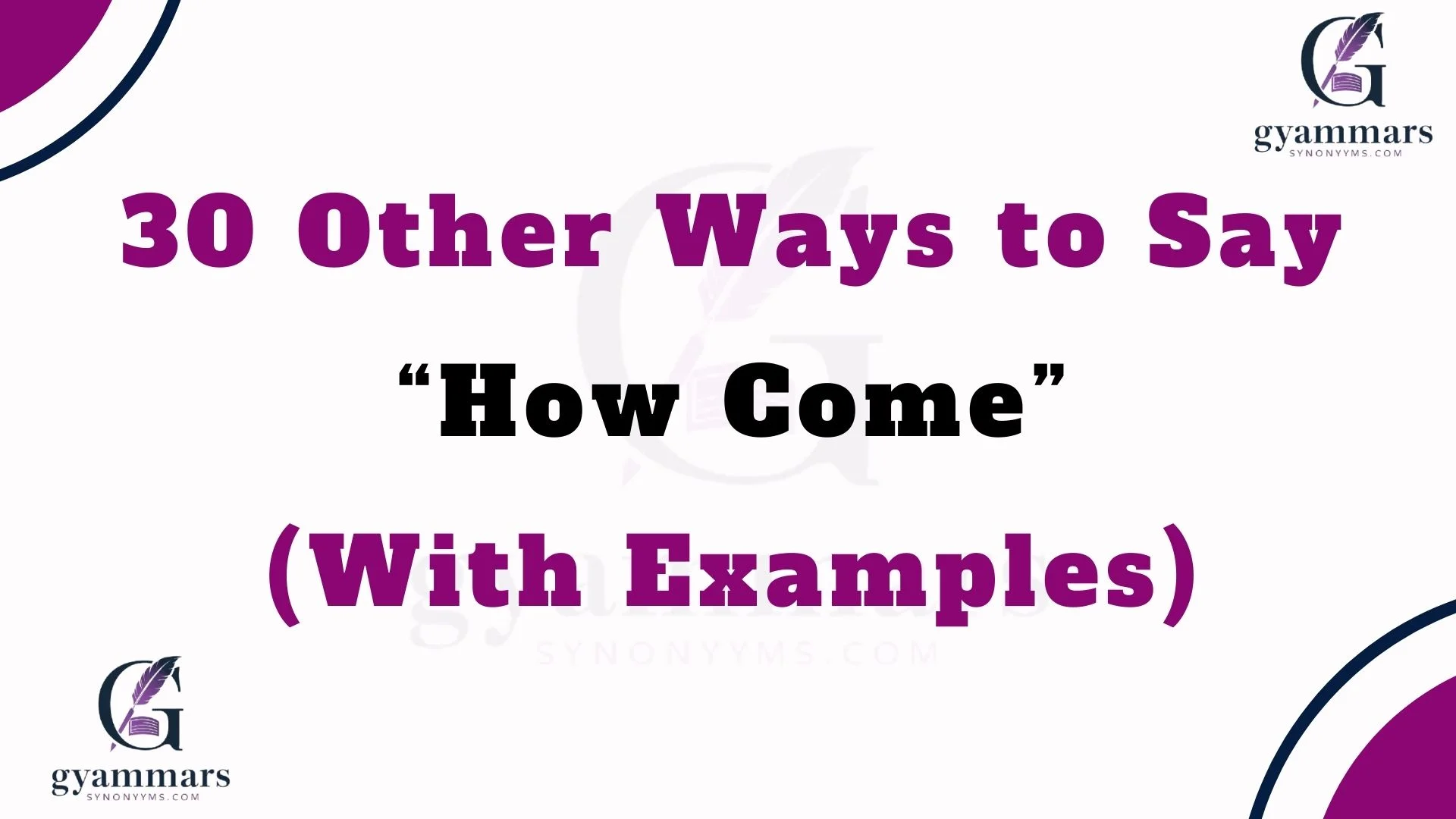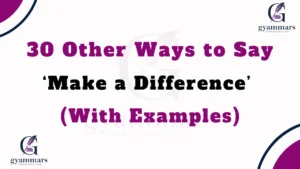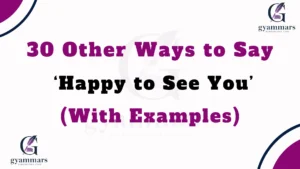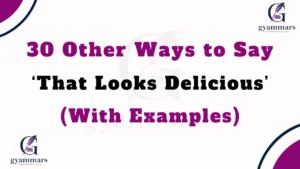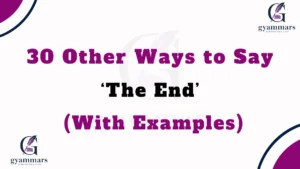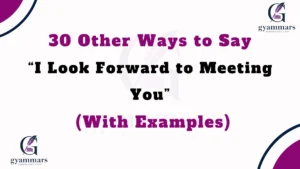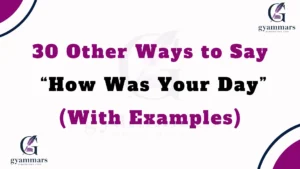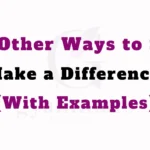Finding the right words can make a huge difference when trying to communicate with warmth, care, and thoughtfulness. “How come” is a casual way to ask why something happened, but sometimes, it may feel too informal or blunt. Using alternatives can make your questions feel more considerate, personal, and meaningful, allowing conversations to flow more smoothly and empathetically.
What Does “How Come” Mean?
Definition: “How come” is a casual way of asking why something is happening or why something is the case.
Detailed Explanation: It’s often used in informal conversation to inquire about reasons behind a situation. While friendly and approachable, it can sometimes sound abrupt depending on the tone and context.
Scenario Examples:
- “How come you didn’t join us for lunch?”
- “How come the project deadline changed?”
Best Use: Use in casual conversations with friends, family, or colleagues you know well.
Tone: Casual, inquisitive, informal
Additional Notes: Avoid in very formal settings as it may seem too relaxed.
Is It Professional/Polite to Say “How Come”?
Using “How come” is generally not considered formal or highly professional. While polite in friendly settings, in professional emails or meetings, phrases like “Could you explain why…” or “May I ask the reason for…” are more appropriate.
Pros: Casual, friendly, easy to understand Cons: Informal, may seem abrupt in professional contexts
Pros and Cons of “How Come”
Pros:
- Easy to use in everyday conversation
- Shows curiosity
Cons:
- Can appear too casual or blunt in formal settings
- May be misunderstood as slightly confrontational if tone is off
Synonyms For “How Come”
- Why is that?
- What’s the reason?
- Why do you think that is?
- How does that happen?
- Can you explain why?
- What’s going on?
- How come it is like that?
- What led to this?
- Could you tell me why?
- What’s the cause?
- How do you explain that?
- What’s the explanation?
- Why might that be?
- How did this come about?
- What’s behind this?
- Can you clarify why?
- What prompted this?
- How did that happen?
- What’s the rationale?
- Why do you say that?
- What brought this about?
- How is that possible?
- Can you shed light on why?
- What’s the thinking behind this?
- How did it come to be?
- Why is it so?
- What accounts for this?
- Can you justify that?
- How did this situation arise?
- Why do you suppose that?
1. Why is that?
Definition: A direct and simple way to ask for a reason.
Detailed Explanation: This phrase is polite and versatile, suitable for most situations.
Scenario Examples:
- “Why is that the meeting was rescheduled?”
- “Why is that your favorite book?”
Best Use: Use when seeking clarification in both casual and semi-formal contexts.
Tone: Neutral, polite, inquisitive
Additional Notes: Very versatile; works well in professional settings.
2. What’s the reason?
Definition: A formal alternative asking for the explanation behind something.
Detailed Explanation: More structured than “how come” and suitable in professional conversations.
Scenario Examples:
- “What’s the reason for the delay?”
- “What’s the reason you prefer working remotely?”
Best Use: Use in professional emails or discussions requiring clear rationale.
Tone: Formal, respectful
Additional Notes: Clear and non-confrontational; appropriate in most contexts.
3. Why do you think that is?
Definition: Invites the other person to share their perspective.
Detailed Explanation: Encourages dialogue and understanding rather than a direct demand for an explanation.
Scenario Examples:
- “Why do you think that is the best approach?”
- “Why do you think that is happening?”
Best Use: Useful in discussions or debates to show curiosity and respect for opinions.
Tone: Thoughtful, collaborative
Additional Notes: Great for fostering empathetic conversations.
4. How does that happen?
Definition: A more descriptive way to inquire about causes.
Detailed Explanation: This phrase emphasizes the process rather than just the reason.
Scenario Examples:
- “How does that happen so quickly?”
- “How does that happen in the system?”
Best Use: When curious about process or circumstances rather than just the outcome.
Tone: Curious, neutral
Additional Notes: Works well when explaining procedures or phenomena.
5. Can you explain why?
Definition: A polite, professional way to request reasoning.
Detailed Explanation: Invites explanation without implying blame.
Scenario Examples:
- “Can you explain why the budget increased?”
- “Can you explain why this decision was made?”
Best Use: Excellent for meetings, emails, and formal discussions.
Tone: Polite, respectful
Additional Notes: Adds professionalism to your question.
6. What’s going on?
Definition: A casual inquiry about a situation or event.
Detailed Explanation: Often used to understand unexpected circumstances.
Scenario Examples:
- “What’s going on with the project?”
- “What’s going on at the office today?”
Best Use: Use in informal or conversational settings.
Tone: Casual, friendly
Additional Notes: Slightly less formal; conveys curiosity rather than judgment.
7. How come it is like that?
Definition: A variation of “how come” for more clarity.
Detailed Explanation: Slightly more descriptive; emphasizes curiosity about current circumstances.
Scenario Examples:
- “How come it is like that with the schedule?”
- “How come it is like that with the software update?”
Best Use: Casual conversations when seeking explanation.
Tone: Informal, inquisitive
Additional Notes: Avoid in formal professional contexts.
8. What led to this?
Definition: A thoughtful way to inquire about reasons or origins.
Detailed Explanation: Focuses on cause or preceding events rather than just the outcome.
Scenario Examples:
- “What led to this misunderstanding?”
- “What led to this decision being made?”
Best Use: Suitable for reflective or analytical discussions.
Tone: Thoughtful, reflective
Additional Notes: Works well in conflict resolution or problem-solving contexts.
9. Could you tell me why?
Definition: Polite and slightly formal alternative.
Detailed Explanation: Requests explanation in a respectful and considerate tone.
Scenario Examples:
- “Could you tell me why the report wasn’t submitted?”
- “Could you tell me why this change occurred?”
Best Use: Emails, meetings, or formal conversations.
Tone: Polite, courteous
Additional Notes: Shows attentiveness and respect for the other person.
10. What’s the cause?
Definition: Direct inquiry into the reason behind something.
Detailed Explanation: Often used in analytical or technical discussions.
Scenario Examples:
- “What’s the cause of the error?”
- “What’s the cause of the delay?”
Best Use: Formal or technical discussions.
Tone: Neutral, analytical
Additional Notes: Focused on cause rather than opinion.
11. How do you explain that?
Definition: Requests a detailed explanation or reasoning.
Detailed Explanation: Focuses on understanding the reasoning behind a situation rather than just the outcome.
Scenario Examples:
- “How do you explain that the system crashed?”
- “How do you explain that she finished so quickly?”
Best Use: Professional or analytical discussions where reasoning is important.
Tone: Curious, formal
Additional Notes: Avoid casual settings; works best in problem-solving contexts.
12. What’s the explanation?
Definition: Formal way of asking for clarification or reasons.
Detailed Explanation: Neutral and versatile, suitable for professional, academic, or serious conversations.
Scenario Examples:
- “What’s the explanation for the sudden price increase?”
- “What’s the explanation behind the data discrepancy?”
Best Use: Professional emails, reports, or meetings.
Tone: Neutral, professional
Additional Notes: Can be used to remain objective while seeking clarity.
13. Why might that be?
Definition: A gentle way to ask for reasons or possibilities.
Detailed Explanation: Less direct than “why is that” and implies curiosity rather than confrontation.
Scenario Examples:
- “Why might that be the case for the delay?”
- “Why might that be causing the error?”
Best Use: Casual or semi-formal discussions; encourages speculation or exploration.
Tone: Curious, thoughtful
Additional Notes: Good for brainstorming or reflective conversations.
14. How did this come about?
Definition: Asks for the process or circumstances leading to a situation.
Detailed Explanation: Focuses on understanding the origin or chain of events.
Scenario Examples:
- “How did this come about so quickly?”
- “How did this come about in the first place?”
Best Use: Reflective or problem-solving contexts.
Tone: Neutral, inquisitive
Additional Notes: Great for discussions about events or decisions.
15. What’s behind this?
Definition: Seeks the underlying reason or motivation.
Detailed Explanation: Encourages deeper exploration of motives, causes, or reasoning.
Scenario Examples:
- “What’s behind this sudden change?”
- “What’s behind this new policy?”
Best Use: Use when wanting insight into decisions, emotions, or strategies.
Tone: Thoughtful, curious
Additional Notes: Works well in interpersonal or strategic discussions.
16. Can you clarify why?
Definition: Polite request for explanation or reasoning.
Detailed Explanation: Offers a professional, respectful way to seek clarity without sounding accusatory.
Scenario Examples:
- “Can you clarify why the timeline was moved?”
- “Can you clarify why the results differ?”
Best Use: Professional emails, meetings, or formal conversations.
Tone: Polite, professional
Additional Notes: Conveys attentiveness and encourages clear communication.
17. What prompted this?
Definition: Asks about the cause or trigger for an action or event.
Detailed Explanation: Focuses on the instigating factor rather than just the result.
Scenario Examples:
- “What prompted this sudden decision?”
- “What prompted this change in schedule?”
Best Use: Meetings, discussions, or reflective inquiries.
Tone: Curious, neutral
Additional Notes: Works well when examining motivation or reasoning.
18. How did that happen?
Definition: Casual or semi-formal way to ask why something occurred.
Detailed Explanation: Can be used to understand both process and result; slightly more conversational than “what led to this.”
Scenario Examples:
- “How did that happen so quickly?”
- “How did that happen with the software?”
Best Use: Casual conversations, workplace discussions, or troubleshooting.
Tone: Neutral, conversational
Additional Notes: Flexible phrasing for most contexts.
19. What’s the rationale?
Definition: Requests reasoning or justification behind a decision or action.
Detailed Explanation: Professional, analytical phrasing suitable for formal discussions.
Scenario Examples:
- “What’s the rationale for this policy?”
- “What’s the rationale behind the design change?”
Best Use: Business meetings, strategy discussions, or academic settings.
Tone: Formal, professional
Additional Notes: Ideal for critical or evaluative conversations.
20. Why do you say that?
Definition: Seeks reasoning behind a statement or opinion.
Detailed Explanation: Focuses on understanding someone’s viewpoint rather than a general cause.
Scenario Examples:
- “Why do you say that the plan will work?”
- “Why do you say that this method is better?”
Best Use: Conversational or debate settings; encourages explanation.
Tone: Polite, curious
Additional Notes: Excellent for dialogue and collaborative discussions.
21. What brought this about?
Definition: Asks about the events or circumstances that led to a situation.
Detailed Explanation: Focuses on cause and effect in a reflective or investigative way.
Scenario Examples:
- “What brought this about?”
- “What brought this about the sudden change in rules?”
Best Use: Problem-solving or reflective discussions.
Tone: Neutral, thoughtful
Additional Notes: Similar to “what led to this,” but slightly more formal.
22. How is that possible?
Definition: Expresses curiosity about the plausibility of a situation.
Detailed Explanation: Often used when something seems surprising or unexpected.
Scenario Examples:
- “How is that possible with the resources we have?”
- “How is that possible that the system failed?”
Best Use: Casual or professional discussions; emphasizes surprise or inquiry.
Tone: Curious, slightly astonished
Additional Notes: Good for highlighting unexpected outcomes.
Also Read This : 30 Other Ways to Say “In Conclusion” (With Examples)
23. Can you shed light on why?
Definition: Polite and professional way to request clarification.
Detailed Explanation: Suggests you’re seeking insight, not questioning someone’s decisions.
Scenario Examples:
- “Can you shed light on why the project was delayed?”
- “Can you shed light on why these results differ?”
Best Use: Emails, meetings, or analytical discussions.
Tone: Polite, respectful
Additional Notes: Shows professional curiosity.
24. What’s the thinking behind this?
Definition: Requests the reasoning or thought process behind a decision.
Detailed Explanation: Focuses on understanding logic or rationale.
Scenario Examples:
- “What’s the thinking behind this marketing strategy?”
- “What’s the thinking behind this schedule?”
Best Use: Professional or analytical discussions.
Tone: Neutral, professional
Additional Notes: Encourages discussion without sounding critical.
25. How did it come to be?
Definition: Asks about the process that led to a situation.
Detailed Explanation: Slightly formal way to inquire about origin or development.
Scenario Examples:
- “How did it come to be that the timeline was shortened?”
- “How did it come to be that this system exists?”
Best Use: Reflective, professional, or analytical contexts.
Tone: Neutral, inquisitive
Additional Notes: Formal alternative to casual “how did this happen.”
26. Why is it so?
Definition: Classic, direct way to ask for reasons.
Detailed Explanation: More formal and traditional; conveys curiosity politely.
Scenario Examples:
- “Why is it so that the prices increased?”
- “Why is it so that the event was canceled?”
Best Use: Formal writing or professional discussions.
Tone: Polite, formal
Additional Notes: Timeless phrasing; ideal for reports or essays.
27. What accounts for this?
Definition: Asks for factors or causes that explain a situation.
Detailed Explanation: Analytical, formal phrasing; suitable for problem-solving.
Scenario Examples:
- “What accounts for this sudden increase in sales?”
- “What accounts for this discrepancy in data?”
Best Use: Professional, analytical, or research settings.
Tone: Formal, neutral
Additional Notes: Excellent for reports or analytical discussions.
28. Can you justify that?
Definition: Requests reasoning or defense of an action or decision.
Detailed Explanation: Slightly more formal and assertive; used when accountability is needed.
Scenario Examples:
- “Can you justify that budget allocation?”
- “Can you justify that strategy?”
Best Use: Professional or evaluative conversations.
Tone: Formal, assertive
Additional Notes: Use carefully; can sound challenging if tone is harsh.
29. How did this situation arise?
Definition: Asks about circumstances leading to a current scenario.
Detailed Explanation: Formal and analytical, suitable for problem-solving.
Scenario Examples:
- “How did this situation arise in the project?”
- “How did this situation arise with the system failure?”
Best Use: Professional, analytical discussions.
Tone: Neutral, formal
Additional Notes: Encourages objective evaluation.
30. Why do you suppose that?
Definition: Polite and thoughtful way to ask for speculation or opinion.
Detailed Explanation: Encourages the other person to share their reasoning or perspective.
Scenario Examples:
- “Why do you suppose that the sales dropped?”
- “Why do you suppose that the client reacted that way?”
Best Use: Casual, semi-formal, or reflective discussions.
Tone: Polite, inquisitive
Additional Notes: Softens the question; great for empathetic conversations.
Conclusion
Finding the right words to ask “why” can make a big difference in how your question is received. While “How come” is casual and friendly, using alternative phrases allows you to communicate with greater warmth, professionalism, or thoughtfulness, depending on the situation.
By choosing the appropriate alternative—whether it’s “Can you explain why?” in a formal setting or “Why do you suppose that?” in a reflective conversation—you can encourage clarity, foster understanding, and make your interactions feel more considerate and empathetic.
Faqs :
1. Is it grammatically correct to say “How come”?
Yes, it’s grammatically correct but informal. It’s mainly used in spoken English or casual writing.
2. Can I use “How come” in professional emails?
It’s better to avoid it in formal or professional emails. Instead, use alternatives like “Could you explain why” or “What’s the reason.”
3. What’s the difference between “How come” and “Why”?
Both mean the same, but “How come” is more casual and conversational, while “Why” works in both formal and informal settings.
4. Is “How come” considered rude?
Not necessarily. Tone matters. It may sound blunt if spoken sharply, but with a friendly tone, it comes across as curious, not rude.
5. Which alternatives are best for polite conversation?
Phrases like “Could you tell me why,” “Can you clarify why,” or “What prompted this” are more polite and professional than “How come.”

“Emma Rose at Grammar Synonyms is your go-to expert for everything related to language and expression. Whether you’re refining your grammar, searching for the perfect synonym, or looking for creative ways to improve your writing, Emma Rose provides the tools and inspiration you need. With a wide range of resources designed to elevate your communication, Grammar Synonyms helps you find just the right words to make every sentence shine.
